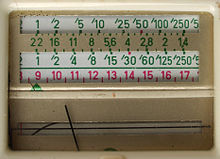Shutter speed


The shutter speed is the exposure time that is created by a camera shutter . It is controlled either purely mechanically or electronically .
technology
The usual shutter speed series halves the length of time that the photographic film or the recording sensor in digital cameras is exposed to light for each setting step . The times on the shutter speed setting wheel of a camera are given in reciprocal values (denominator of the fraction).
As an example, this results in the following time series in fractions of a second, as displayed by cameras:
- 1 - 2 - 4 - 8 - 15 - 30 - 60 - 125 - 250 - 500 - 1000 - 2000 - 4000
This representation is common (and easy to remember), but the correct reciprocal values should be as follows:
- 1 - 2 - 4 - 8 - 16 - 32 - 64 - 128 - 256 - 512 - 1024 - 2048 - 4096
At each stage of this time series, the amount of light that exposes the film is halved . Shorter exposure times can be compensated for by larger apertures (= smaller f-stops ), whereby one level of the aperture series corresponds to one level of the time series.
Compared to the classic time and aperture series, cameras with an electronic shutter can control various other exposure times. In addition to shorter and, in particular, longer shutter speeds, intermediate steps can often be set manually in half or third f-stops; in automatic mode, practically stepless settings are possible.
Simply equipped camera models with automatic programs often no longer display the electronically selected time / aperture combination.
This series can often be found on old cameras or lenses with a central shutter :
- 1 - 2 - 5 - 10 - 25 - 50 - 100 - 250 - 500
The shortest time that can be set can also differ and be, for example, 1/200 s or 1/300 s.
Designations
Depending on the camera, the shutter speed setting wheel or the shutter speed display shows special names:
- AUTO stands for automatic exposure, so that the camera controls the exposure depending on the aperture. For cameras without a shutter speed dial, this function is set using the exposure program (usually “P”, “A”, “S”, “M” or “P”, “Av”, “Tv”, “M”).
- B (Bulb) enables long exposures and opens the shutter as long as the shutter button is pressed. With electronically controlled cameras, this setting is often only available in manual mode "M" (rarely also in automatic shutter mode "S").
- Like “B”, T (Time) enables long-term exposures, with the shutter opening when the shutter release button is pressed for the first time and only closed again when the shutter release button is pressed again. Such a position of the time wheel is only offered by a few older cases.
- X or a flash symbol (also called X-Sync in some camera menus) stands for the flash synchronization time. For cameras with a focal plane shutter , this is the shortest exposure time in which the film or sensor is completely illuminated for a moment. At this moment the flash ignites ( the main flash with TTL flash measurement ). With shorter exposure times, the 2nd shutter curtain starts to run and already covers parts of the film / sensor again, although the 1st shutter curtain has not yet expired and therefore areas of the film / sensor have not yet been exposed. Usual values for the flash synchronization time are 1/60 s - 1/300 s depending on the camera model, shorter values are achieved by multiple flashes (high-speed synchronization). A few older electronically controlled camera models do not automatically set the shortest X-Sync time.
Conversion of shutter speed factor and f-stop
If, for example, an extension of the exposure by 3 steps is specified for a filter, then this corresponds to the extension by three notches either on the aperture ring or on the shutter speed setting wheel. An extension factor is applied to the exposure time. The following relationship exists between the extension factor and detents:
Image effect
The choice of shutter speed, in addition to setting the correct exposure, as well as the choice of aperture have a major influence on the image effect. With a short shutter speed, fast movements can be “frozen”, while a relatively long exposure time enables movements to be displayed dynamically by blurring. Such effects should not be confused with blurring .
- Image composition with different shutter speeds
Individual evidence
- ↑ Matthias Paul: BULB in automatic iris with the Minolta 7000 AF, 9000 AF, 7000i / 7700i and 8000i / 8700i . In: Contribution to the Minolta forum on September 21, 2004 (accessed July 10, 2011).



